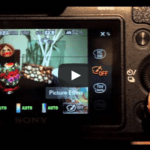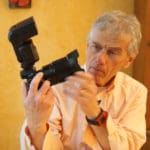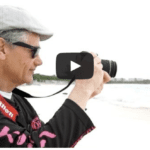After reviewing the Sony NEX-VG20 in 2011, I purchased one. I also purchased an NEX-5n still camera, several lenses and accessories. I’ve been using that kit happily and productively ever since for both stills and video.
I was eager to review the NEX-VG30, and Sony Canada very graciously lent me one for about a month. That’s a long time and in addition to some test shoots, I was able to use it for a variety of shoots. The results are in the video.
How long does it take to write a review?
I started writing early in the loan period, and changed both my opinion and what I perceived to be facts several times during the month. My process is to work with the equipment, write some details of my impressions and then find a way to visualize those impressions. It does turn into a learning process as I continue to investigate and capture the images and scenes to illustrate my thoughts. So, I’m glad I was able to borrow the camera for a whole month – it has provided a far more nuanced view.
That said, you find some niggly details when you spend that much time, and I felt that was starting to overwhelm my generally very positive impressions. Hopefully my enthusiasm for these cameras (the VG20 and 30) comes through.
Detailed notes:
I’ve provided some links in the video, to allow you to quickly access sections of the review and to link out to longer videos that I’ve posted to evaluate the three Sony E-series 18-200 zoom lenses and the quality of audio recording with the on-camera mic. Let me know if that’s useful.
Several of the scenes in the video were shot on May 25th at Fort George in Niagara on the Lake, at the re-enactment of the Battle for Fort George 200 years earlier. Although I’m pictured with the VG20 for illustrating the statement made in the narration, all of the footage was shot with the VG30. I created a kit that allowed me to mount the camera on top of a monopod (Manfrotto 679B) with a monitor (Sony CLM-V55) and a wired remote control (RM-AV2) at the bottom for remote viewing of the scene and remote control of zoom as well as start/stop (see 5:05). I chose the wired remote as it has a clip to hold onto the monopod. It’s also somewhat more reliable, as the remote IR sensor is actually on the front of the camera. I balanced the fully extended monopod against my belt for stability. I tried both standard and active stabilization, but it’s still pretty shakey. It’s obviously a configuration that doesn’t lend itself to the kind of “steady” shots I prefer. This setup is not really feasible with a VG20. Note that I did mount the power zoom lens on the VG20 to see if the remote control would work (it doesn’t)
However, what you see is the great quality, both day and night, that this camera delivers. Most shots where taken in auto focus and auto exposure modes. I do wish that video had some data capture capability like EXIF for stills, so that afterwards I could see what settings were used.
It’s my observation that in scenarios where you’re grabbing candid shots like this, it’s not really possible to be very artistic – carefully composing a shot, adjusting the depth of field to maximum potential. Things happen fast, and you can’t really anticipate what’s happening next. But I’m still learning.
The slow shutter shot was a challenge. I first tried it at night, but wasn’t happy with the results. Slowing the shutter in daylight results in a very overexposed shot. I used a 67mm Hoya ND8 filter to get the shot. And that’s why adding an internal ND is a feature request. If you do want to use capabilities like a large aperture for shallow depth of field or slower shutter in daylight, you need ND to give you some exposure control.
Capturing the auto-exposure adjustment was also tricky. It really took the right combination of factors to illustrate this, and the auto on the VG30 is so fast, you barely get to see the change (at 2:05). It’s also evident on the shots of the VG30 on a tripod against the brick wall (3:50). Those shots are taken with the NEX 5n in auto exposure. <
The ability to touch the screen to change focus and exposure (2:25) is good and often works well. However, it’s not very reliable for quality production work. On the other hand, it does take a great deal of practice to get this right if you’re trying to do it manually.<
Some of the screen captures (starting at 3:00) are slightly cut off – an artifact of the camera’s output. These scenes are recorded directly from the HDMI output. All of the screen captures are scaled at 90%, to keep them inside action safe.
The shots of the VG30’s electronic viewfinder (EVF) (3:10) are taken with the Sony E-series macro lens, and don’t really do the quality of the EVF justice. Side-by-side, it is dramatically better in size (it fills the screen) and quality (colour purity, contrast) to the VG20’s.
I thank my friend Peter for the loan of the SLE18200LE lens.
We see the cardinals (4:43) quite frequently at our backyard feeder. If anyone has suggestions to keep the squirrels on the ground (7:40), instead of climbing onto the feeder, I’m all ears.
Maybe you’re wondering why the lens doesn’t move when I use the lever on the lens at 5:30? The camera is turned off.
The picture effects (starting at 9:03) are a composite. I recorded the scene with the changes at Fort George, and then recorded the settings at home over a black background. So, yes – you can make picture effects adjustments on the fly (even if the overlay says “STBY”) while you’re recording. The two scenes (with some editing of the overlay) are composited using a luma key. At first I was planning to get a separate scene for each effect, so that it could be seen at maximum advantage/effect, but abandoned that concept. Obviously, these are all things you could do in post (especially with more advanced software like Sony’s Vegas, or Apple’s Final Cut). You can find both instructions and free filters to create a miniature effect with a Google search.
I thank Calla and Ali, The Toronto Choral Society, Scarlett Jane, and Stratford’s production of Tommy for their performances. The link will take you to un-narrated versions of those performances.
I’m always happy to read your comments and suggestions and do respond to everyone. Please let me know what I can do better, or which topics would be of interest to you for future posts and videos.
Production Details:
The video is shot using a Sony NEX-VG-30, NEX-5n and NEX-VG20, with the SLE18-200 lens, unless otherwise noted. I use an audiotechnica AT2020 for voice overs. Music by Magiv Garage Band, and performers as noted onscreen. Manfrotto tripod (190xb+701hdv). The video is edited in FInal Cut X on an iMac. The font for supers is ITC Franklin Gothic Demibold.




